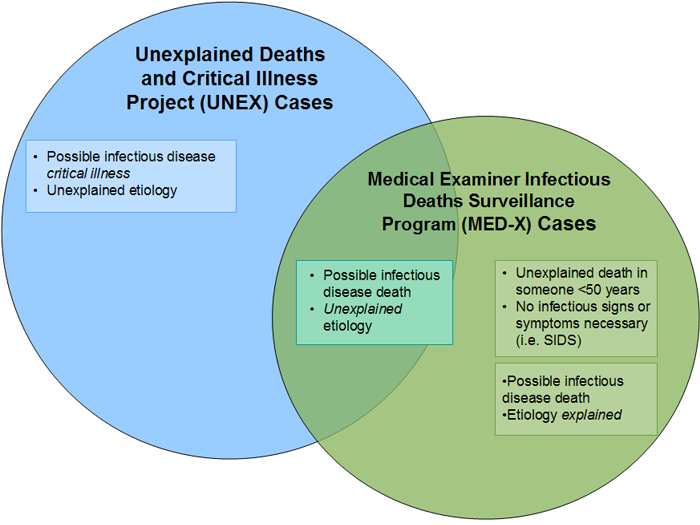Contact Info
Infectious Disease Epidemiology, Prevention and Control Division
651-201-5414
MED-X Frequently Asked Questions
On this page:
What are infectious signs, symptoms, hallmarks of disease?
How does MED-X relate to the UNEX?
How long until I can expect testing results?
How should we store and ship specimens?
What are considered infectious signs and symptoms or hallmarks of disease?
- Antemortem Signs/Symptoms:
- Fever
- Acute encephalopathy or new onset seizures
- Acute flaccid paralysis or polyneuropathy
- New-onset jaundice
- Acute diarrhea
- New rash or soft tissue lesion
- Postmortem Syndromes
- Encephalitis and Meningitis
- Pharyngitis, epiglottitis, acute bronchitis
- Pneumonia
- Myocarditis or Endocarditis
- Acute hepatitis or fulminant hepatic necrosis
- Colitis
- Lymphadenitis
- Diffuse rash or soft tissue lesion
- Sepsis syndrome
How does MED-X relate to the Unexplained Deaths and Critical Illness Project (UNEX)?
The MED-X surveillance includes unexplained deaths reported to the UNEX program, but in addition, it includes explained infectious deaths and those deaths that are unexplained in healthy, young individuals regardless of if there are infectious signs and symptoms present (i.e. SIDS cases).

How long until I can expect testing results?
- Testing is an ongoing process that often involves several rounds.
- For viral cultures, results can come back as early as one week and up to 21 days.
- PCR testing is often conducted here at the MDH laboratory and generally takes about one to two weeks for results.
- Testing on formalin and paraffin fixed tissue is done at CDC and will take longer to process, from one to several months.
- Cases sometimes have unique important public health implications and testing is done as rapidly as possible in those instances.
How should we store and ship specimens?
- MED-X Specimen Collection and Testing.
- In general, formalin and paraffin tissue should be kept at room temperature. Fresh tissue and fluids can be refrigerated and shipped on ice if sent within 48 hours of collection. Once a specimen has been frozen, it should be kept frozen for shipment.
Last Updated: 07/02/2025